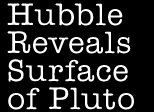

| "All the news that's fit to link" |
|
Last updated March 13th 1996 |

M arch 14th is not a national holiday, not yet anyway. But for the past eight years, the Exploratorium has been celebrating it as Pi Day. Pi day falls on March 14th (3/14) and the Pi Ceremony occurs at 1:59 PST at the National Pi Shrine inside the Exploratorium (3.14159...). Recently, I discussed Pi Day and the number Pi with the Exploratorium's Larry Shaw.
Related Sites The Ridiculously Enhanced Pi Page The Uselessness of Pi and its irrational friends

T he Hubble Space Telescope has done it again. This time its target was the planet Pluto. Just two months ago, the Hubble Space Telescope gave scientists a unique look at distant galaxies. Now the Hubble has given scientists their first look at the surface of this the most distant planet in our solar system. The frigid surface revealed some bright white spots that scientists believe are caused by frozen nitrogen. The temperature on Pluto ranges from minus 380 degrees Fahrenheit (when the planet is farthest from the sun) to minus 350 degrees (when the planet is nearest the sun). It's been 66 years since Pluto was discovered by Clyde Tombaugh. The astronomer is now 90 years old and when saw Hubble's images of Pluto, he said that he never thought the technology would be able to do this while he was still alive.
Related Sites HST Images of the Surface of Pluto CNN Interactive: Hubble Captures First Surface Views of Pluto The San Francisco Chronicle: Scientists Show Off Pictures of Pluto's Face Live from the Hubble Space Telescope
"What's New in Science" is published the middle of every month. Remember to check back next month and see "What's New!" |

Over six million feet of wire was connected in schools from San Diego to Eureka. Among the thousands of volunteers were Bill Clinton and Al Gore. The President and Vice President pulled cable at San Ygnacio Valley High School in Concord.
The Exploratorium participated in NetDay '96 by helping to wire Bryant Elementary School's after school/daycare center. Back in September, students from Bryant had an opportunity to meet President Clinton when he visited the Exploratorium.
At Bryant it was about more than just wiring-- the after school center also got three computers. These computers were donated by Youth for Service, a San Francisco non-profit organization. Volunteers from the Exploratorium and Youth for Service helped configure the computers and get them on the Internet.
CNN Interactive: 2,000 California Schools Get Wired
What's New in the World of Science: October Edition
When you blow across the top of a Coke bottle, the rush of air can cause a vibration to build up in the bottle which we experience as a rather pleasing note. The pitch or frequency of the note changes with the depth of the liquid in the bottle.
When you start blowing air over the mouth of the bottle, a puff of air (compression wave) travels downward, bounces off the surface below, and travels back to the opening. When it arrives (less than a thousandth of a second later), it disturbs the flow of air that you are still producing across the top. This causes a slightly bigger puff of air to start again on its way down the bottle. This happens repeatedly until a very large (and loud) vibration is built up and you hear it as sound. Since the time taken for the back and forth trip depends on the depth of the liquid, the pitch that you hear changes as that varies.
Try filling a series of Coke bottles with different amounts of water. You can fill the bottles until you have a musical scale like a piano, or make up your own and compose a "Concerto for Bottle and Breath."
Ron Hipschman
Comments and suggestions are always welcomed.
|

|

|

|
| The Learning Studio | The Exploratorium |